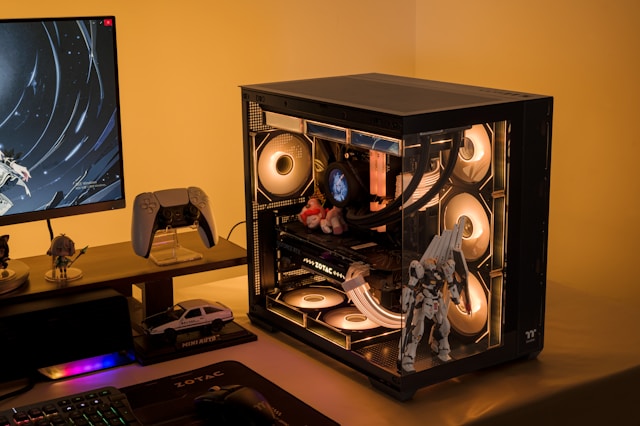Building your own PC is an exciting journey, whether you’re creating a high-performance gaming machine or a powerful workstation. With the right approach, you can build a system that perfectly matches your needs and budget. Let’s break it down step by step.
Everything You Need to Know About PC Components
Each component in your PC plays a crucial role. Here’s what you need to know:
CPU (The Brain of Your PC)
The Central Processing Unit (CPU) handles all the calculations and instructions that keep your PC running.
- More cores = better multitasking
- Higher clock speed = better single-thread performance
- Leading brands: Intel & AMD
Motherboard (The Connection Hub)
Your motherboard determines what parts are compatible with your PC.
- Choose the right socket for your CPU
- Pick a form factor (ATX, Micro-ATX, Mini-ITX) based on your case size
- Consider features like USB ports, overclocking support, and expansion slots
RAM (Speed Booster)
Random Access Memory (RAM) allows your PC to quickly access data.
- 8GB minimum, but 16GB+ is recommended for gaming and heavy tasks
- Check motherboard compatibility before buying
- Higher speeds = better performance
Storage (Where Everything Lives)
You have two main options:
- SSD (Solid State Drive) – Faster boot times, better overall speed
- HDD (Hard Disk Drive) – More storage for a lower cost
- Best setup: SSD for OS, HDD for storage
Graphics Card (For Gamers & Creators)
If you’re into gaming or video editing, you need a dedicated Graphics Processing Unit (GPU).
- VRAM (Video Memory) is key – More is better for high-resolution gaming
- Brands: NVIDIA & AMD
Power Supply (PSU) (Keeping It Running)
Your PSU delivers power to all components.
- Choose wattage based on your components’ needs
- Look for 80 PLUS efficiency ratings
- Modular PSUs = better cable management
Cooling (Preventing Overheating)
- Air cooling is affordable and effective
- Liquid cooling is great for overclocking and extreme performance
- Proper cooling extends your PC’s lifespan
PC Case (Your Rig’s Home)
- Ensure it fits your motherboard and GPU
- Look for good airflow and cable management options
- Choose a style that suits you, from minimalist to RGB-lit setups
Planning Your Build
Before buying parts, consider:
- Purpose: Gaming? Work? Video editing?
- Budget: Balance between affordability and performance
- Compatibility: Ensure all parts work together
- Future-proofing: Choose upgradeable components
Building Your Custom PC
- Prepare your workspace – Have a clean, static-free area
- Install the CPU – Handle carefully, align it properly
- Mount the RAM – Insert into the correct slots with a firm push
- Attach storage drives – Secure SSDs or HDDs into place
- Install the PSU – Connect power cables to motherboard & components
- Secure the GPU – Slot into PCIe port and fasten screws
- Manage cables – Keep things tidy for better airflow
- Power up & test – Boot into BIOS to check if everything is working
Installing Your Operating System & Drivers
- Create a bootable USB drive with Windows, Linux, or macOS
- Enter BIOS and set USB as the boot device
- Follow installation prompts
- Install essential drivers for GPU, motherboard, and peripherals
- Optimize settings – Adjust power options and disable unnecessary startup programs
Keeping Your PC Running Smoothly
- Regular cleaning – Dust buildup can overheat components
- Update drivers & OS – Keep everything running optimally
- Back up important files – Use cloud or external drives
- Run antivirus scans – Protect against malware
Upgrading Your PC
Want better performance? Consider upgrading:
- RAM – More memory = faster multitasking
- GPU – Better graphics for gaming & editing
- SSD – Faster load times & more storage
- Cooling – More fans or liquid cooling for overclocking
Need Help? Tech4U Has You Covered!
Tech4U’s experts can guide you through every step, from choosing components to setting up your build. Whether you need help troubleshooting or optimizing performance, their team is ready to assist.
Final Thoughts
Building a custom PC is rewarding and fun! With careful planning and the right components, you can create a system that fits your needs perfectly. Ready to get started? Happy building!

